Determining the Size of Representative Volume Elements for a Two-Dimensional Random Aggregate Numerical Model of Asphalt Mortar without Damage
Abstract
:1. Introduction
2. Manufacturing of Asphalt Mortar Numerical Model RVE
2.1. Calculating the Area Proportion of 2D Aggregates in Each Particle Size Range
2.2. Generating Random Aggregates
2.3. Placing Random Aggregates
2.4. Generating Random Voids
3. Geometric Analysis of the Asphalt Mortar Numerical Model RVE
3.1. Analysis of the Proportion of 2D Aggregate Area
3.2. Analysis of 2D Aggregate Angles
3.3. Density Uniformity Analysis
3.4. Summary of Geometric Analysis
4. Virtual Dynamic Compression Modulus Test of Asphalt Mortar Numerical Model RVE
4.1. Definition of Numerical Models
4.2. Numerical Calculation and Result Processing
4.3. Analysis of Numerical Calculation Results
5. Discussion of Geometric Analysis and Numerical Analysis Results
5.1. Geometric Analysis and Numerical Analysis Results of the Numerical Model RVE for Asphalt Mortar
5.2. Relationship between Geometric and Numerical Analysis Methods
6. Conclusions and Recommendations for Future Research
6.1. Conclusions
- (1)
- When using RVE to characterize the linear viscoelastic mechanical behavior of asphalt mortar, it is also necessary to deeply analyze the internal microstructure changes of asphalt mortar under the linear viscoelastic mechanical behavior. The minimum size of the asphalt mortar numerical model RVE in a nondestructive state is determined by the geometric analysis results. In this case, the minimum sizes corresponding to the asphalt mortar 2D random aggregate numerical model RVE with the largest particle sizes of 1.18 and 2.36 mm are 4 × 4 and 6 × 6 mm, respectively.
- (2)
- If RVE is used to characterize the linear viscoelastic mechanical behavior of asphalt mortar, there is no need to delve into the internal microstructural changes of asphalt mortar under the linear viscoelastic mechanical behavior. The minimum size of the asphalt mortar numerical model RVE in a nondestructive state can be determined according to the numerical analysis results. In this case, the minimum size corresponding to the 2D random aggregate numerical model RVE of asphalt mortar with maximum particle sizes of 1.18 and 2.36 mm is 3 × 3 mm.
6.2. Recommendations for Future Research
- (1)
- The main factor affecting the size of asphalt mortar’s RVE is the size and distribution of aggregates. To simplify the analysis, this manuscript directly uses the asphalt mastic parameters from the literature. In the future, when researchers refer to the method presented in this study to determine the RVE size of asphalt mortar numerical models, they should consider conducting dynamic modulus tests on asphalt mastic, and using the Prony series parameters obtained from the test data as the material parameters to obtain simulation results that correspond to reality.
- (2)
- This study used geometric and numerical analysis to provide the minimum size of the numerical model RVE for asphalt mortar in a non-destructive state but did not use this conclusion to conduct cross-scale simulations from asphalt mastic to asphalt mortar. In the future, relevant numerical simulations should be conducted, and the simulation results should be compared with actual experimental results to further validate the conclusions obtained in this study.
- (3)
- Due to limited computing resources, we have referred to a simplified scheme from the literature, and only conducted virtual tests on dynamic viscoelastic properties at a certain temperature and loading frequency. In the future, when readers refer to this research method to determine the size of RVE, they should conduct dynamic viscoelastic properties virtual experiments at different temperatures and loading frequencies to further discuss the impact of different loading conditions on RVE size.
Author Contributions
Funding
Institutional Review Board Statement
Informed Consent Statement
Data Availability Statement
Conflicts of Interest
References
- Underwood, B. Multiscale Constitutive Modeling of Asphalt Concrete. Ph.D. Thesis, North Carolina State University, Raleigh, NC, USA, 2011. [Google Scholar]
- Aigner, E.; Lackner, R.; Pichler, C. Multiscale prediction of viscoelastic properties of asphalt concrete. J. Mater. Civ. Eng. 2009, 21, 771–780. [Google Scholar] [CrossRef]
- Leischner, S.; Canon Falla, G.; Rochlani, M.; Zeißler, A.; Wellner, F. Experimental Methods for the Mechanical Characterization of Asphalt Concrete at Different Length Scales: Bitumen, Mastic, Mortar and Asphalt Mixture. In Coupled System Pavement-Tire-Vehicle; Springer: Berlin/Heidelberg, Germany, 2021; pp. 121–161. [Google Scholar]
- Arshadi, A.; Bahia, H. Development of an image-based multi-scale finite-element approach to predict mechanical response of asphalt mixtures. Road Mater. Pavement Des. 2015, 16 (Suppl. S2), 214–229. [Google Scholar] [CrossRef]
- Zhang, Y.; Leng, Z. Quantification of bituminous mortar ageing and its application in ravelling evaluation of porous asphalt wearing courses. Mater. Des. 2017, 119, 1–11. [Google Scholar] [CrossRef]
- Szydłowski, C.; Smakosz, Ł.; Stienss, M.; Górski, J. The use of a two-phase Monte Carlo material model to reflect the dispersion of asphalt concrete fracture parameters. Theor. Appl. Fract. Mech. 2022, 119, 103326. [Google Scholar] [CrossRef]
- Zhao, S.; You, Q.; Sesay, T. Fine aggregate sizes effects on the creep behavior of asphalt mortar. Constr. Build. Mater. 2022, 342, 127931. [Google Scholar] [CrossRef]
- Chen, M.; Javilla, B.; Hong, W.; Pan, C.; Riara, M.; Mo, L.; Guo, M. Rheological and interaction analysis of asphalt binder, mastic and mortar. Materials 2019, 12, 128. [Google Scholar] [CrossRef]
- Gu, L.; Chen, L.; Zhang, W.; Ma, H.; Ma, T. Mesostructural modeling of dynamic modulus and phase angle master curves of rubber modified asphalt mixture. Materials 2019, 12, 1667. [Google Scholar] [CrossRef] [PubMed]
- Cao, P.; Jin, F.; Shi, F.; Zhou, C.; Feng, D. Modified two-phase micromechanical model and generalized self-consistent model for predicting dynamic modulus of asphalt concrete. Constr. Build. Mater. 2019, 201, 33–41. [Google Scholar]
- Tan, Z.; Leng, Z.; Jiang, J.; Cao, P.; Jelagin, D.; Li, G.; Sreeram, A. Numerical study of the aggregate contact effect on the complex modulus of asphalt concrete. Mater. Des. 2022, 213, 110342. [Google Scholar] [CrossRef]
- Sherzer, G.; Gao, P.; Schlangen, E.; Ye, G.; Gal, E. Upscaling cement paste microstructure to obtain the fracture, shear, and elastic concrete mechanical LDPM parameters. Materials 2017, 10, 242. [Google Scholar] [CrossRef]
- Nayak, S. Multiscale and Multiphysics Modeling of Durable Infrastructure Materials. Ph.D. Thesis, University of Rhode Island, South Kingstown, RI, USA, 2020. [Google Scholar]
- Wimmer, J.; Stier, B.; Simon, J.-W.; Reese, S. Computational homogenisation from a 3D finite element model of asphalt concrete—Linear elastic computations. Finite Elem. Anal. Des. 2016, 110, 43–57. [Google Scholar] [CrossRef]
- Kim, Y.-R.; Lutif, J.E.S.; Allen, D.H. Determining representative volume elements of asphalt concrete mixtures without damage. Transp. Res. Rec. 2009, 2127, 52–59. [Google Scholar] [CrossRef]
- Kim, Y.; Lee, J.; Lutif, J.E. Geometrical evaluation and experimental verification to determine representative volume elements of heterogeneous asphalt mixtures. J. Test. Eval. 2010, 38, 660–666. [Google Scholar] [CrossRef]
- Dai, Q.; You, Z. Prediction of creep stiffness of asphalt mixture with micromechanical finite-element and discrete-element models. J. Eng. Mech. 2007, 133, 163–173. [Google Scholar] [CrossRef]
- Wang, H.; Zhang, C.; Yang, L.; You, Z. Study on the rubber-modified asphalt mixtures’ cracking propagation using the extended finite element method. Constr. Build. Mater. 2013, 47, 223–230. [Google Scholar] [CrossRef]
- Xu, J.; Zheng, C. Random generation of asphalt mixture mesostructure and thermal–mechanical coupling analysis at low temperature. Constr. Build. Mater. 2021, 280, 122537. [Google Scholar] [CrossRef]
- Bekele, A.; Balieu, R.; Jelagin, D.; Ryden, N.; Gudmarsson, A. Micro-mechanical modelling of low temperature-induced micro-damage initiation in asphalt concrete based on cohesive zone model. Constr. Build. Mater. 2021, 286, 122971. [Google Scholar] [CrossRef]
- Cao, P.; Jin, F.; Feng, D.; Zhou, C.; Hu, W. Prediction on dynamic modulus of asphalt concrete with random aggregate modeling methods and virtual physics engine. Constr. Build. Mater. 2016, 125, 987–997. [Google Scholar] [CrossRef]
- Leng, Z.; Tan, Z.; Cao, P.; Zhang, Y. An efficient model for predicting the dynamic performance of fine aggregate matrix. Comput. Civ. Infrastruct. Eng. 2021, 36, 1467–1479. [Google Scholar] [CrossRef]
- Jiang, J.; Ni, F.; Gu, X.; Yao, L.; Dong, Q. Evaluation of aggregate packing based on thickness distribution of asphalt binder, mastic and mortar within asphalt mixtures using multiscale methods. Constr. Build. Mater. 2019, 222, 717–730. [Google Scholar] [CrossRef]
- Ozer, H.; Ghauch, Z.G.; Dhasmana, H.; Al-Qadi, I.L. Computational micromechanical analysis of the representative volume element of bituminous composite materials. Mech. Time-Depend. Mater. 2016, 20, 441–453. [Google Scholar] [CrossRef]
- Karki, P.; Kim, Y.-R.; Little, D.N. Dynamic modulus prediction of asphalt concrete mixtures through computational micromechanics. Transp. Res. Rec. J. Transp. Res. Board 2015, 2507, 1–9. [Google Scholar] [CrossRef]
- Liang, S.; Luo, R. Fabrication and numerical verification of two-dimensional random aggregate virtual specimens for asphalt mixture. Constr. Build. Mater. 2021, 279, 122455. [Google Scholar] [CrossRef]
- Liang, S.; Liao, M.; Tu, C.; Luo, R. Fabricating and determining representative volume elements of two-dimensional random aggregate numerical model for asphalt concrete without damage. Constr. Build. Mater. 2022, 357, 129339. [Google Scholar] [CrossRef]
- Khodadadi, M.; Khodaii, A.; Absi, J.; Tehrani, F.F.; Hajikarimi, P. Numerical and analytical length scale investigation on viscoelastic behavior of bituminous composites: Focusing on mortar scale. Constr. Build. Mater. 2022, 350, 128775. [Google Scholar] [CrossRef]
- Masad, E.; Muhunthan, B.; Shashidhar, N.; Harman, T. Internal structure characterization of asphalt concrete using image analysis. J. Comput. Civ. Eng. 1999, 13, 88–95. [Google Scholar] [CrossRef]
- JTG F40-2004; Technical Specifications for Construction of Highway Asphalt Pavements. Ministry of Transport of the People’s Republic of China: Beijing, China, 2004.
- Khodadadi, M.; Khodaii, A.; Absi, J.; Tehrani, F.F.; Hajikarimi, P. An experimental length scale investigation on viscoelastic behavior of bituminous composites: Focusing on mortar scale. Constr. Build. Mater. 2021, 308, 124766. [Google Scholar] [CrossRef]
- Tschoegl, N.W. The Phenomenological Theory of Linear Viscoelastic Behavior: An Introduction; Springer Science & Business Media: Berlin/Heidelberg, Germany, 2012. [Google Scholar]
- JTG E20-2011; Standard Test Methods of Bitumen and Bituminous Mixtures for Highway Engineering. Ministry of Transport of the People’s Republic of China: Beijing, China, 2011.
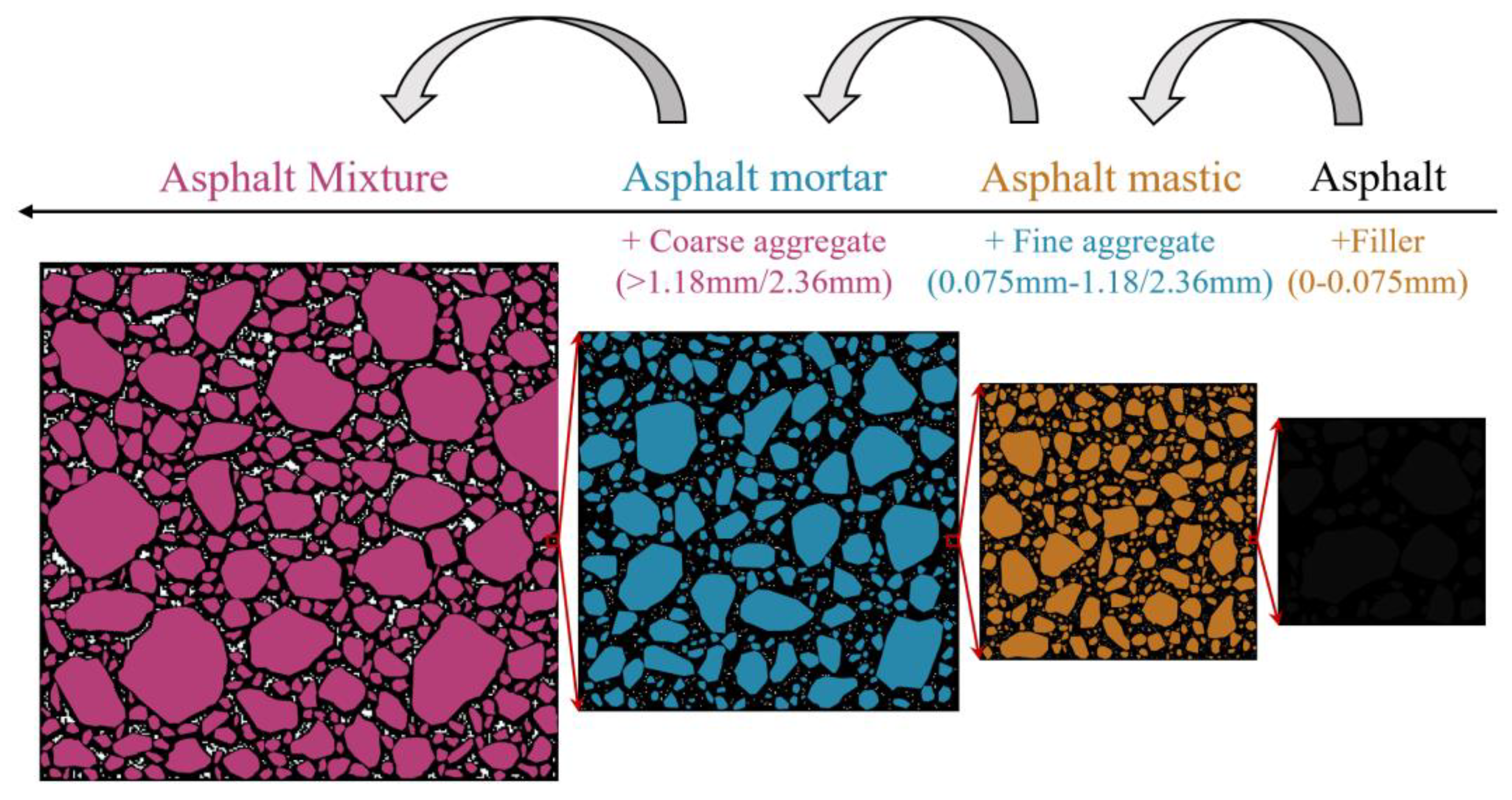


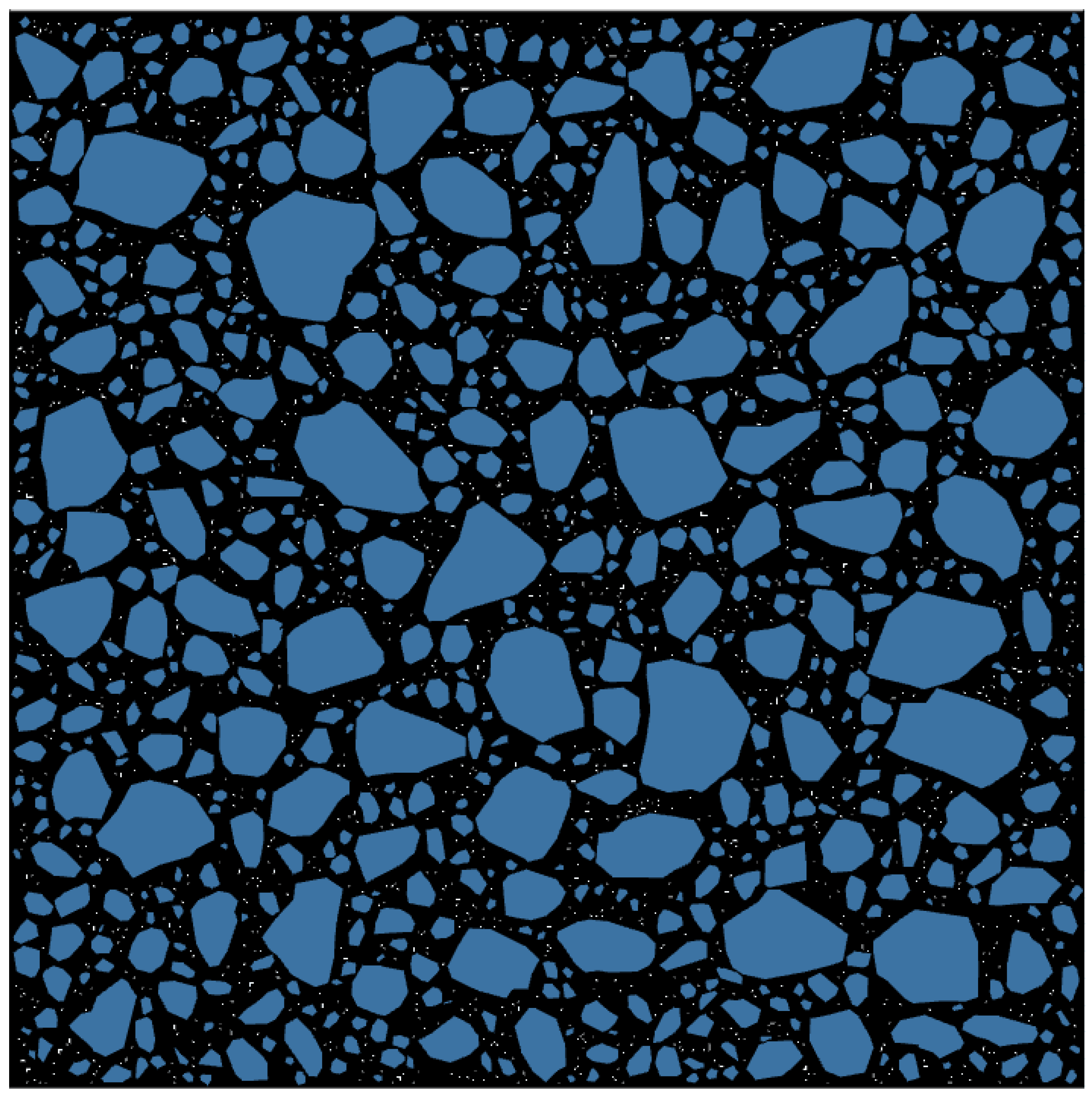

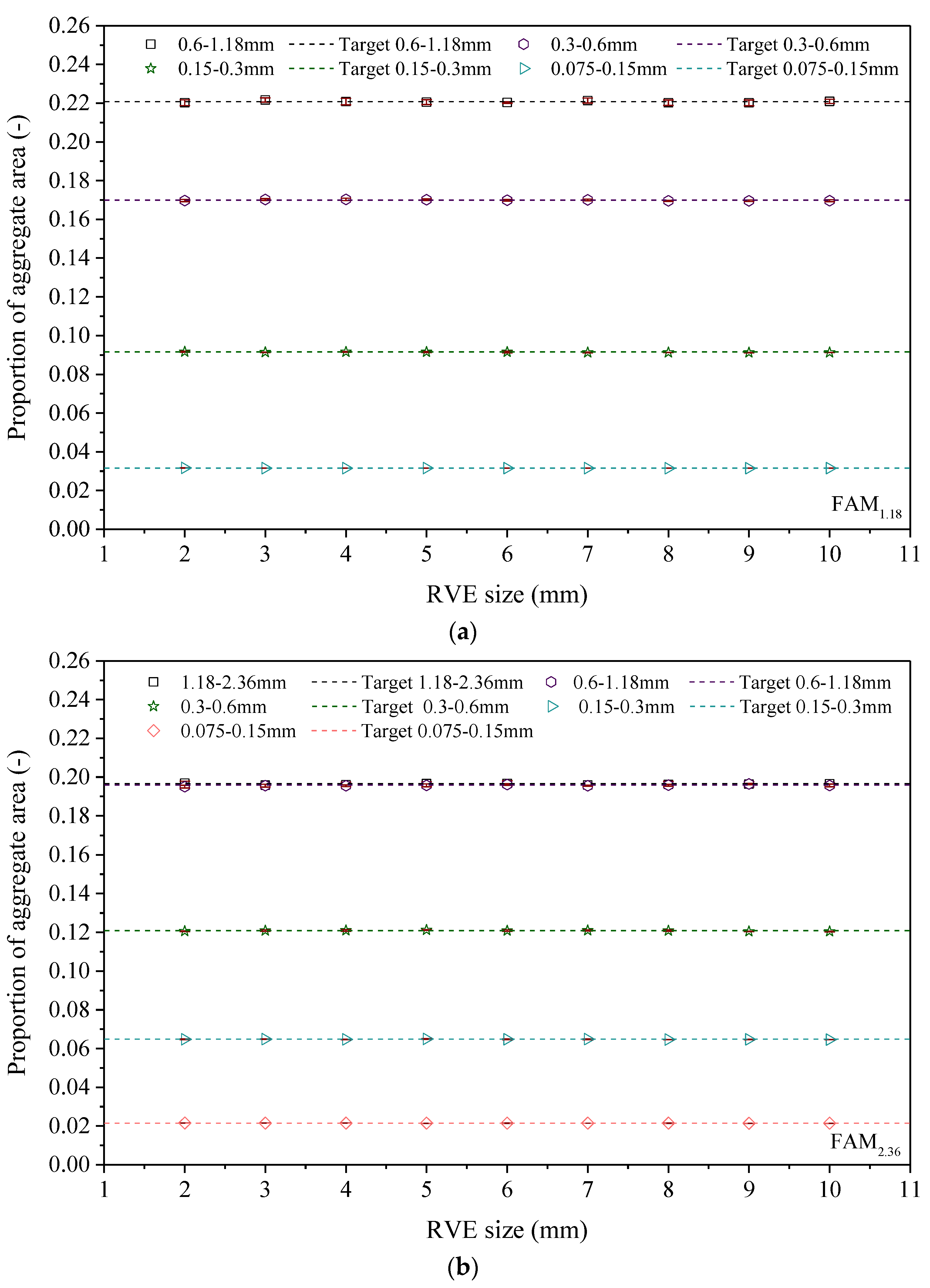
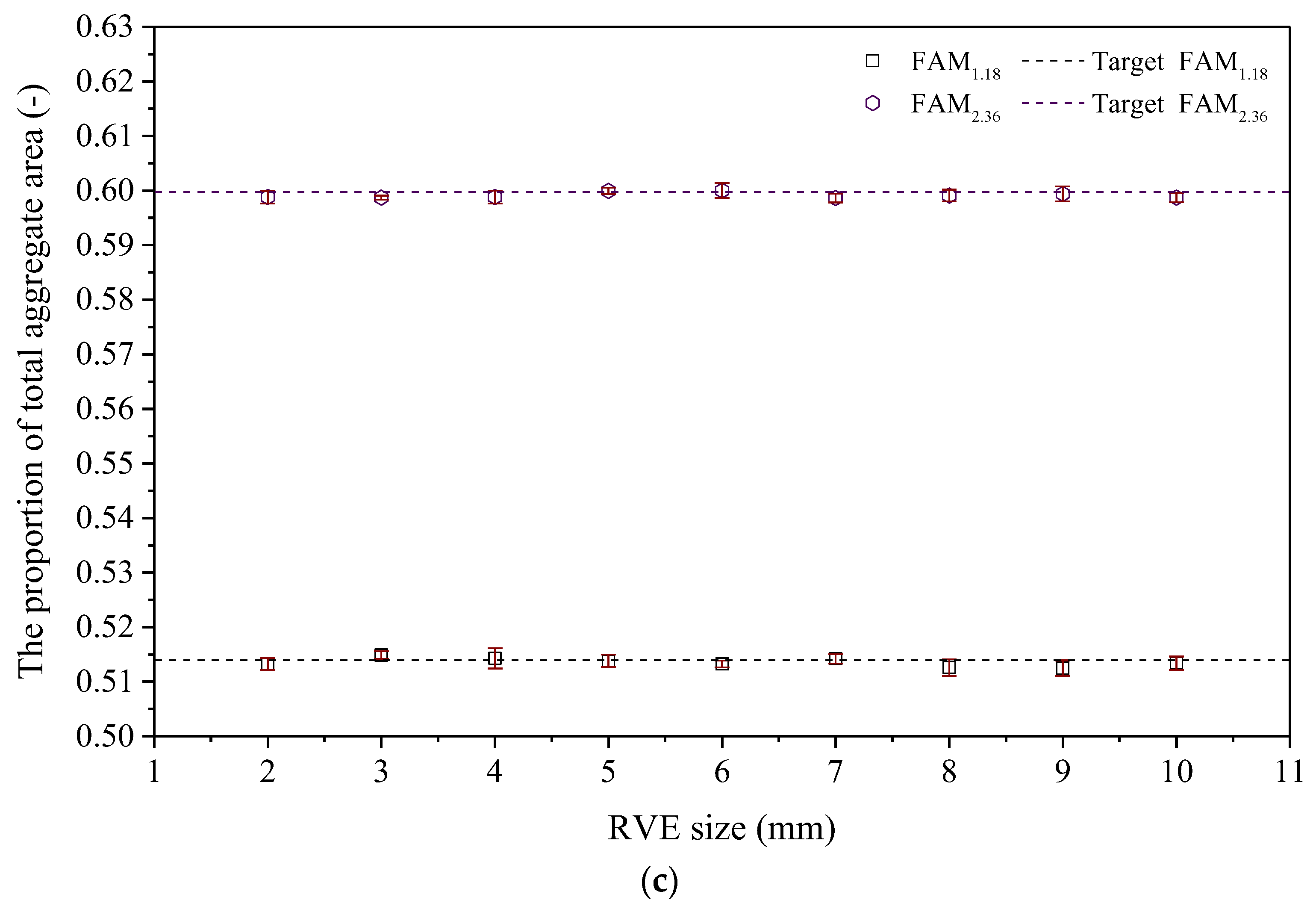

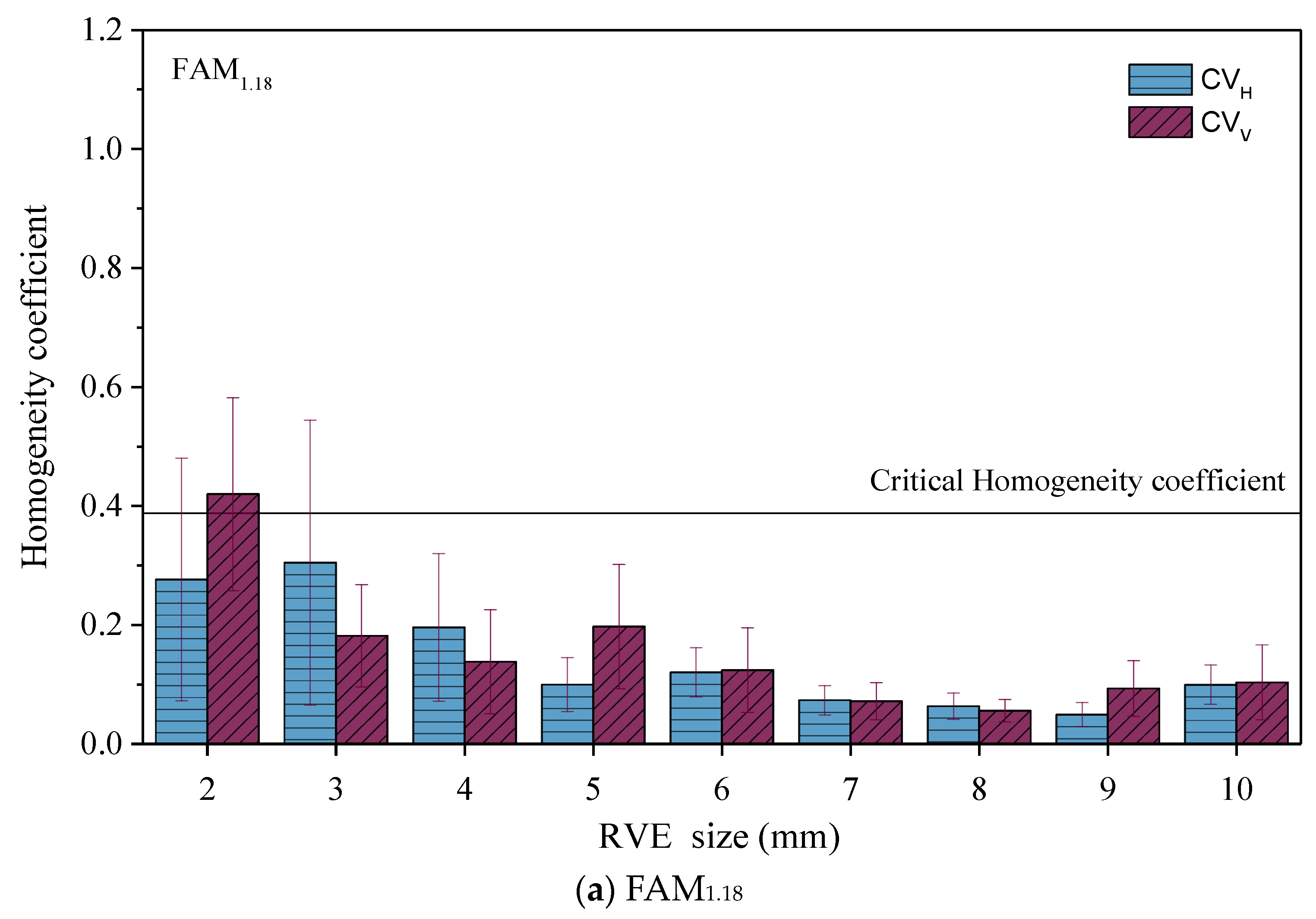

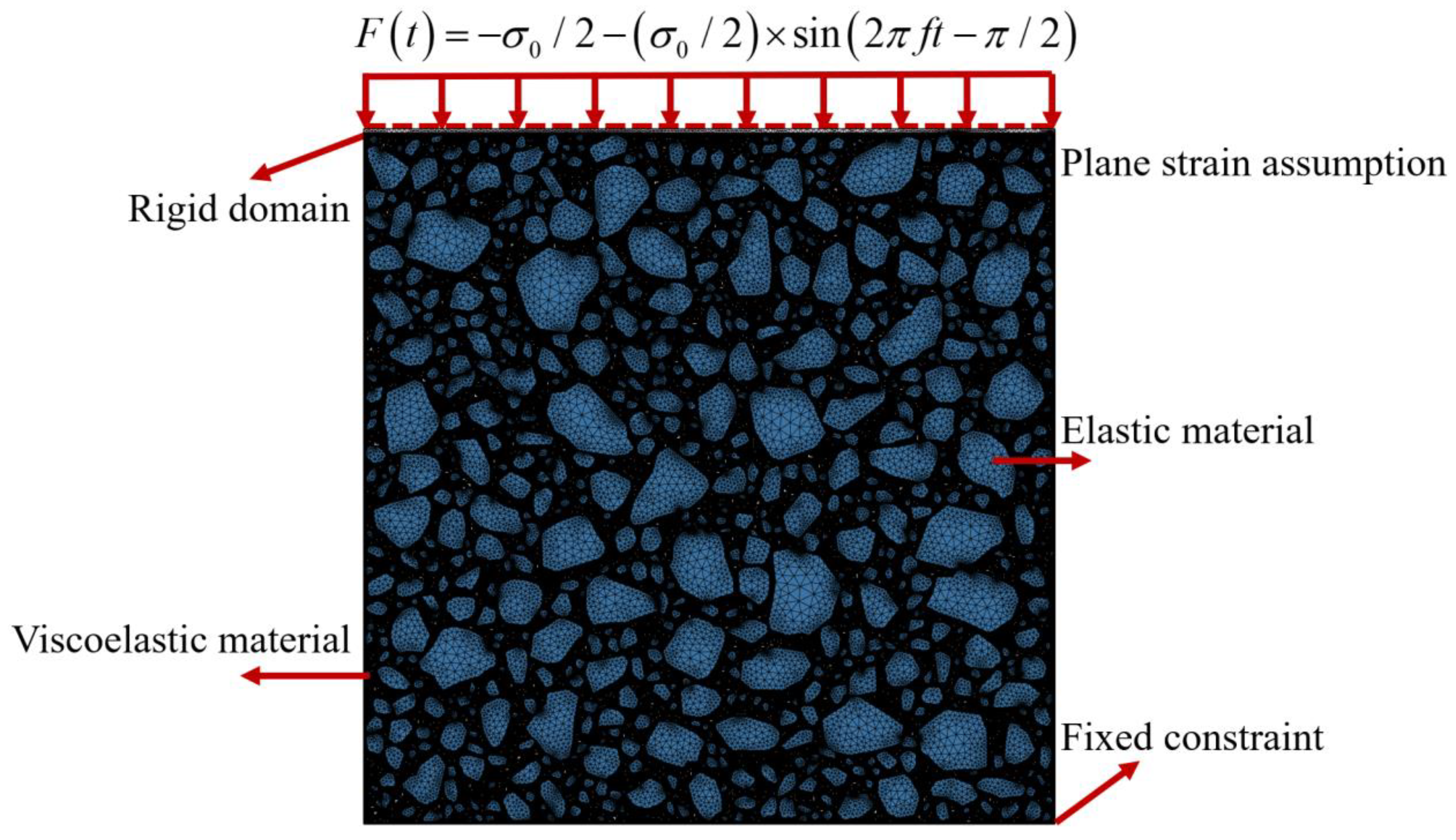
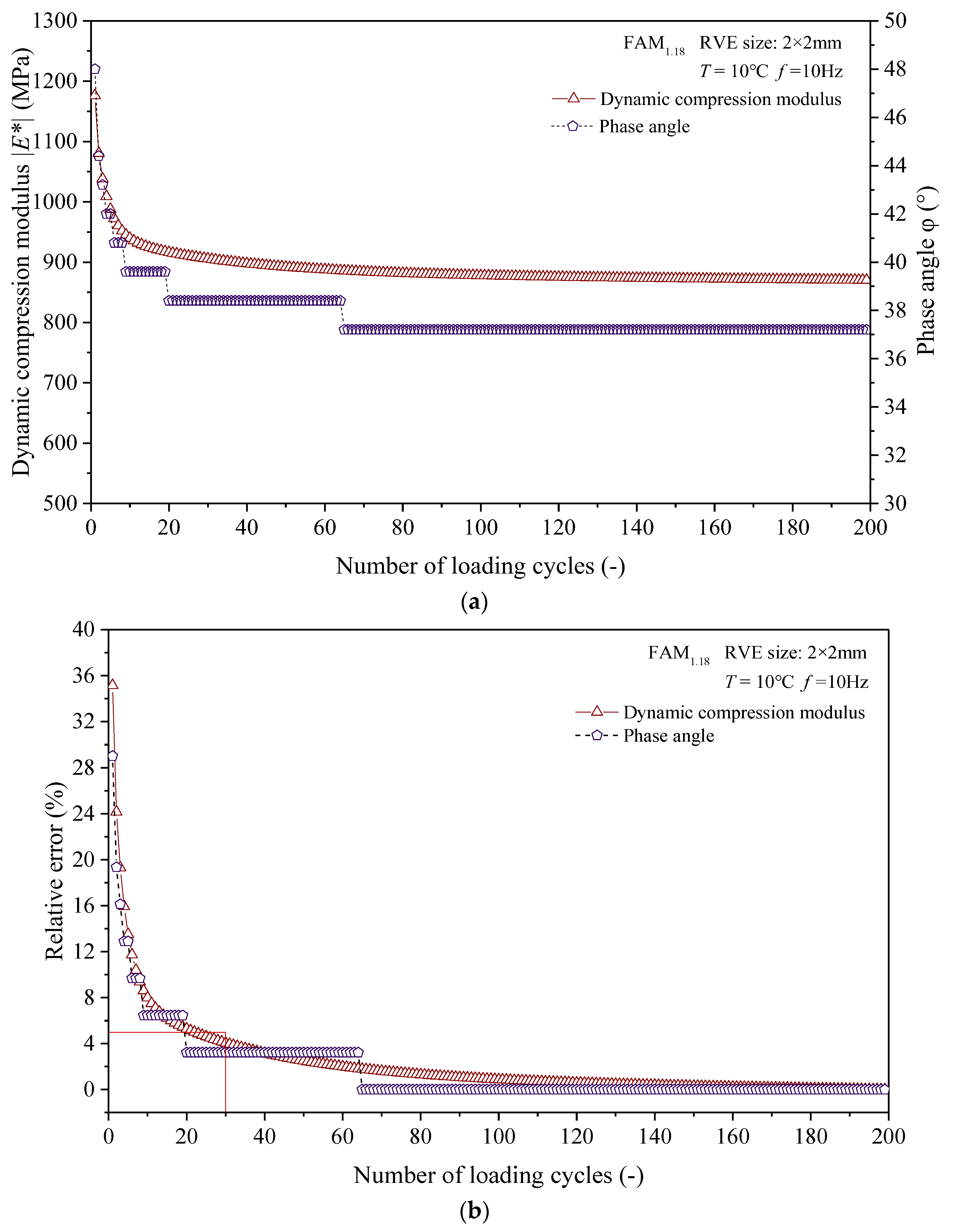
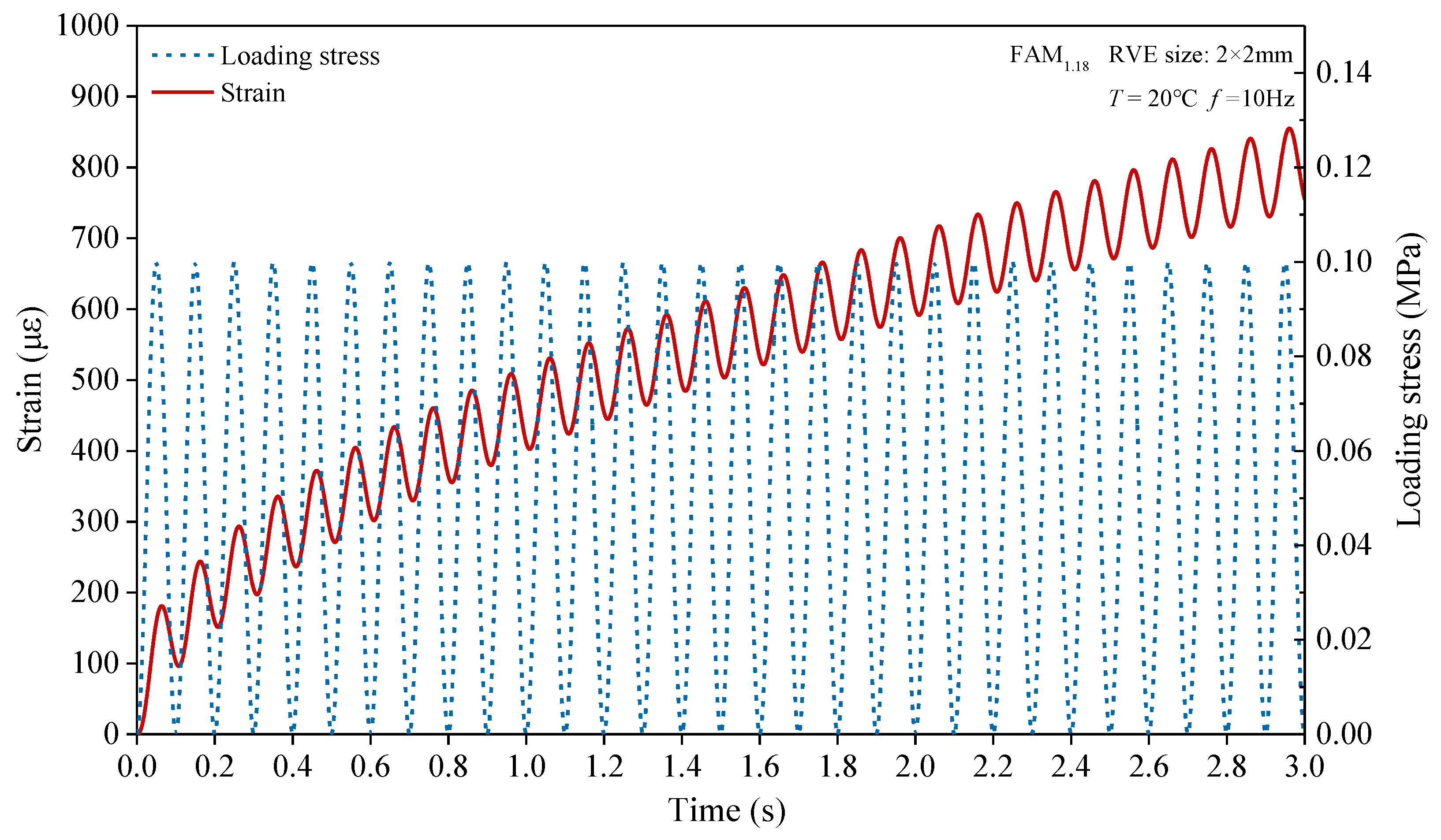

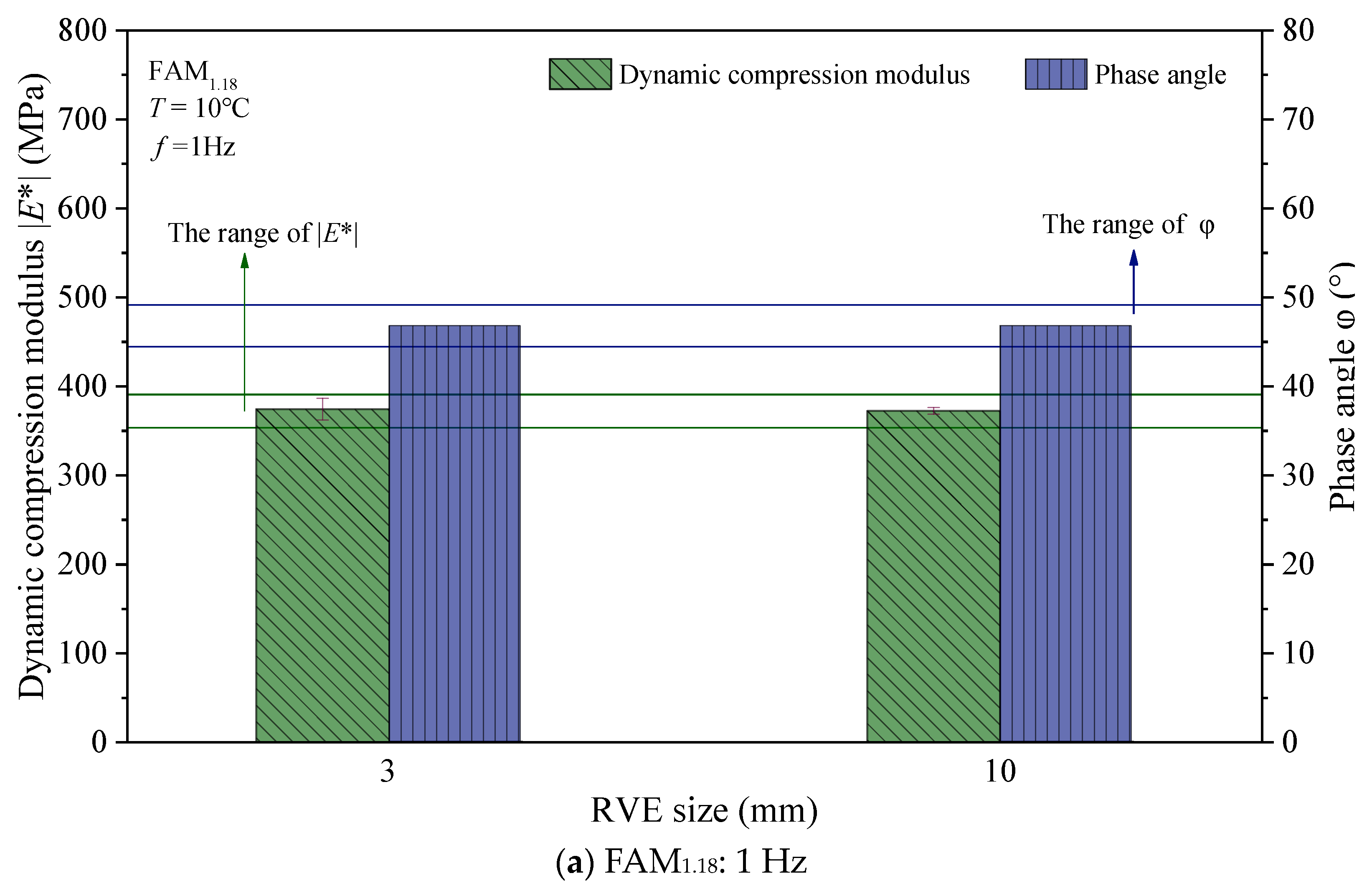

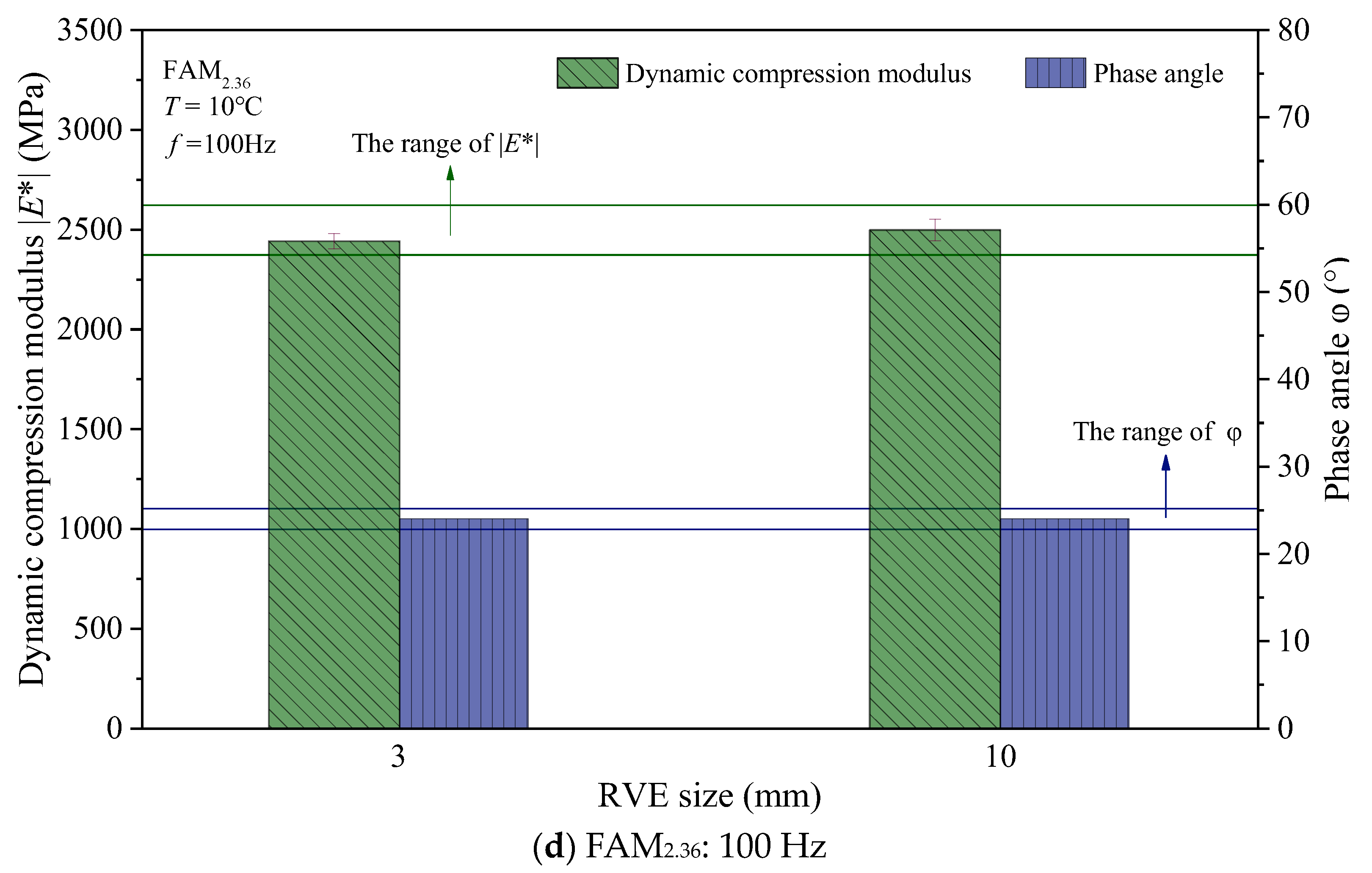
| Sieve Size (mm) | Percentage of Mass Passing Sieve (%) | ||
|---|---|---|---|
| AC-25C | FAM2.36 | FAM1.18 | |
| 31.5 | 100 | — | — |
| 26.5 | 99.2 | ||
| 19 | 78.3 | ||
| 16 | 68.4 | ||
| 13.2 | 58.9 | ||
| 9.5 | 46.3 | ||
| 4.75 | 34.3 | ||
| 2.36 | 23.1 | 100 | |
| 1.18 | 16.0 | 69.3 | 100 |
| 0.6 | 10.2 | 44.2 | 63.8 |
| 0.3 | 7.3 | 31.6 | 45.6 |
| 0.15 | 5.6 | 24.2 | 35.0 |
| 0.075 | 5.1 | 22.1 | 31.9 |
| 0 | 0 | 0 | 0 |
| Asphalt content (%) | 3.75 | 9.73 | 10.54 |
| Void ratio (%) | 4.1 | 1.59 | 1.19 |
| VMA (%) | 12.1 | 22.53 | 23.87 |
| Sieve Size (mm) | Percentage of Area Passing Sieve (%) | Size Range (mm) | Proportion of 2D Aggregate Area (%) | ||
|---|---|---|---|---|---|
| FAM2.36 | FAM1.18 | FAM2.36 | FAM1.18 | ||
| 2.36 | 100 | - | - | - | - |
| 1.18 | 74.6 | 100 | 1.18–2.36 | 19.7 | - |
| 0.6 | 49.3 | 71.0 | 0.6–1.18 | 19.6 | 22.1 |
| 0.3 | 33.7 | 48.7 | 0.3–0.6 | 12.1 | 17.0 |
| 0.15 | 25.4 | 36.6 | 0.15–0.3 | 6.5 | 9.2 |
| 0.075 | 22.6 | 32.5 | 0.075–0.15 | 2.1 | 3.2 |
| 0 | 0 | 0 | - | - | - |
| Particle Size (mm) | Edge Length (mm) | ||||||||
|---|---|---|---|---|---|---|---|---|---|
| 10 | 9 | 8 | 7 | 6 | 5 | 4 | 3 | 2 | |
| 0.6–1.18 | 57.3 | 46.4 | 36.7 | 28.1 | 20.6 | 14.3 | 9.2 | 5.2 | 2.3 |
| 0.3–0.6 | 173.1 | 140.2 | 110.8 | 84.8 | 62.3 | 43.3 | 27.7 | 15.6 | 6.9 |
| 0.15–0.3 | 386.5 | 313.1 | 247.4 | 189.4 | 139.2 | 96.6 | 61.8 | 34.8 | 15.5 |
| 0.075–0.15 | 529.2 | 428.6 | 338.7 | 259.3 | 190.5 | 132.3 | 84.7 | 47.6 | 21.2 |
| Particle Size (mm) | Edge Length (mm) | ||||||||
|---|---|---|---|---|---|---|---|---|---|
| 10 | 9 | 8 | 7 | 6 | 5 | 4 | 3 | 2 | |
| 1.18–2.36 | 12.5 | 10.1 | 8.0 | 6.1 | 4.5 | 3.1 | 2.0 | 1.1 | 0.5 |
| 0.6–1.18 | 50.8 | 41.2 | 32.5 | 24.9 | 18.3 | 12.7 | 8.1 | 4.6 | 2.0 |
| 0.3–0.6 | 123.1 | 99.7 | 78.8 | 60.3 | 44.3 | 30.8 | 19.7 | 11.1 | 4.9 |
| 0.15–0.3 | 273.8 | 221.8 | 175.3 | 134.2 | 98.6 | 68.5 | 43.8 | 24.6 | 11.0 |
| 0.075–0.15 | 360.0 | 291.6 | 230.4 | 176.4 | 129.6 | 90.0 | 57.6 | 32.4 | 14.4 |
| Asphalt Mortar Type | FAM2.36 | FAM1.18 |
|---|---|---|
| Voids (%) | 1.588 | 1.192 |
| Type | (g/cm3) | (g/cm3) | (g/cm3) |
|---|---|---|---|
| FAM1.18 | 2.75 | 2.0 | 0 |
| FAM2.36 |
| Asphalt Mortar Type | Proportion of Aggregate Area | Aggregate Angle | Uniformity of Density |
|---|---|---|---|
| FAM1.18 | 2 × 2 mm | 4 × 4 mm | 3 × 3 mm |
| FAM2.36 | 2 × 2 mm | 6 × 6 mm | 3 × 3 mm |
| Type | Elastic Modulus (GPa) | Poisson’s Ratio (-) | Density (g/cm3) |
|---|---|---|---|
| Aggregate | 40 | 0.15 | 2.75 |
| Asphalt mastic | - | 0.4 | 2.0 |
| i | ρi (s) | Ei (MPa) | i | ρi (s) | Ei (MPa) |
|---|---|---|---|---|---|
| 1 | 1.00 × 106 | 0.02 | 8 | 1.00 × 10−1 | 81.93 |
| 2 | 1.00 × 105 | 0.03 | 9 | 1.00 × 10−2 | 224.94 |
| 3 | 1.00 × 104 | 0.15 | 10 | 1.00 × 10−3 | 320.27 |
| 4 | 1.00 × 103 | 0.51 | 11 | 1.00 × 10−4 | 231.83 |
| 5 | 1.00 × 102 | 1.86 | 12 | 1.00 × 10−5 | 218.43 |
| 6 | 1.00 × 101 | 6.64 | 13 | 1.00 × 10−6 | 170.26 |
| 7 | 1.00 × 100 | 23.80 | Ee = 0.55 MPa | ||
| Asphalt Mortar Type | Geometric Analysis | Analysis of Virtual Dynamic Compression Modulus Test Results |
|---|---|---|
| FAM1.18 | 4 × 4 mm | 3 × 3 mm |
| FAM2.36 | 6 × 6 mm | 5 × 5 mm |
Disclaimer/Publisher’s Note: The statements, opinions and data contained in all publications are solely those of the individual author(s) and contributor(s) and not of MDPI and/or the editor(s). MDPI and/or the editor(s) disclaim responsibility for any injury to people or property resulting from any ideas, methods, instructions or products referred to in the content. |
© 2024 by the authors. Licensee MDPI, Basel, Switzerland. This article is an open access article distributed under the terms and conditions of the Creative Commons Attribution (CC BY) license (https://creativecommons.org/licenses/by/4.0/).
Share and Cite
Liang, S.; Tao, J.; Zhao, X.; Liu, Z.; Zhang, D.; Tu, C. Determining the Size of Representative Volume Elements for a Two-Dimensional Random Aggregate Numerical Model of Asphalt Mortar without Damage. Materials 2024, 17, 3387. https://doi.org/10.3390/ma17143387
Liang S, Tao J, Zhao X, Liu Z, Zhang D, Tu C. Determining the Size of Representative Volume Elements for a Two-Dimensional Random Aggregate Numerical Model of Asphalt Mortar without Damage. Materials. 2024; 17(14):3387. https://doi.org/10.3390/ma17143387
Chicago/Turabian StyleLiang, Sheng, Jing Tao, Xiaoming Zhao, Zhong Liu, Derun Zhang, and Chongzhi Tu. 2024. "Determining the Size of Representative Volume Elements for a Two-Dimensional Random Aggregate Numerical Model of Asphalt Mortar without Damage" Materials 17, no. 14: 3387. https://doi.org/10.3390/ma17143387





